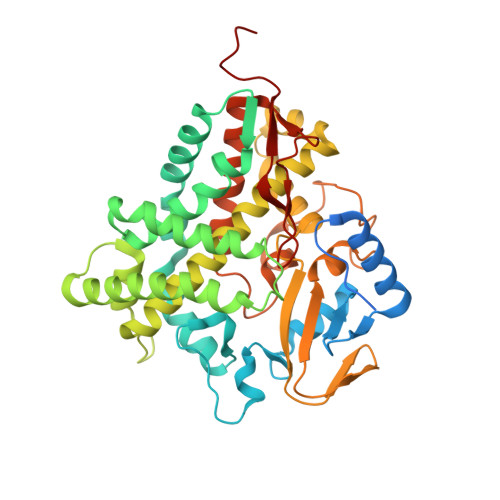Investigating the Structural Plasticity of a Cytochrome P450: Three-Dimensional Structures of P450 Eryk and Binding to its Physiological Substrate.
Savino, C., Montemiglio, L.C., Sciara, G., Miele, A.E., Kendrew, S.G., Jemth, P., Gianni, S., Vallone, B.(2009) J Biological Chem 284: 29170
- PubMed: 19625248
- DOI: https://doi.org/10.1074/jbc.M109.003590
- Primary Citation of Related Structures:
2JJN, 2JJO, 2WIO - PubMed Abstract:
Cytochrome P450s are heme-containing proteins that catalyze the oxidative metabolism of many physiological endogenous compounds. Because of their unique oxygen chemistry and their key role in drug and xenobiotic metabolism, particular attention has been devoted in elucidating their mechanism of substrate recognition. In this work, we analyzed the three-dimensional structures of a monomeric cytochrome P450 from Saccharopolyspora erythraea, commonly called EryK, and the binding kinetics to its physiological ligand, erythromycin D. Three different structures of EryK were obtained: two ligand-free forms and one in complex with its substrate. Analysis of the substrate-bound structure revealed the key structural determinants involved in substrate recognition and selectivity. Interestingly, the ligand-free structures of EryK suggested that the protein may explore an open and a closed conformation in the absence of substrate. In an effort to validate this hypothesis and to investigate the energetics between such alternative conformations, we performed stopped-flow absorbance experiments. Data demonstrated that EryK binds erythromycin D via a mechanism involving at least two steps. Contrary to previously characterized cytochrome P450s, analysis of double jump mixing experiments confirmed that this complex scenario arises from a pre-existing equilibrium between the open and closed subpopulations of EryK, rather than from an induced-fit type mechanism.
- CNR Institute of Molecular Biology and Pathology, P.le A. Moro 5, 00185 Rome, Italy.
Organizational Affiliation:

















